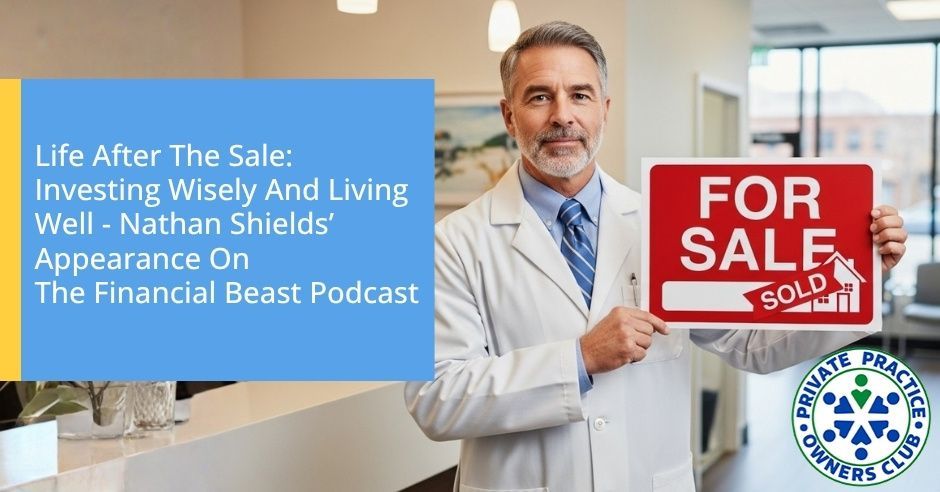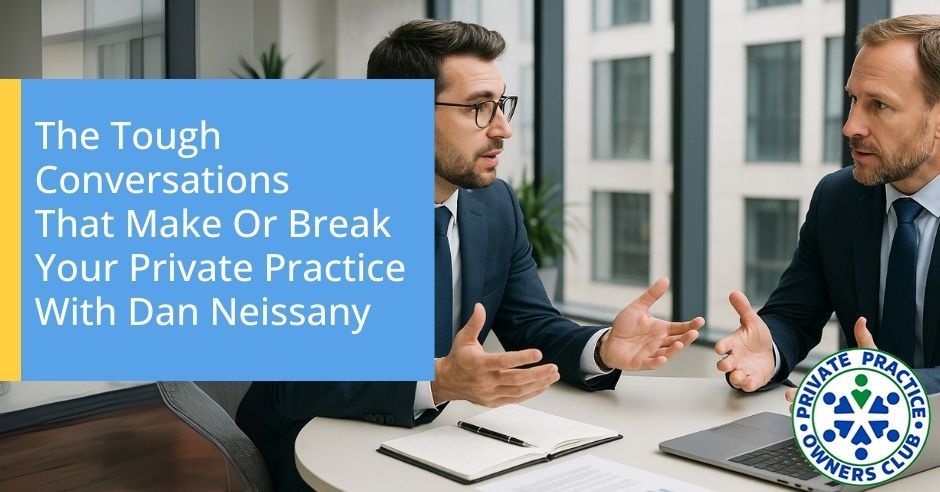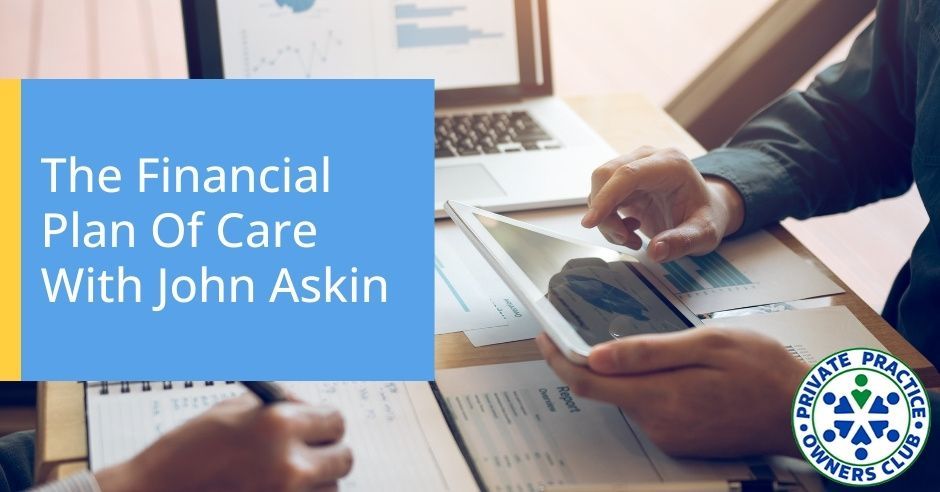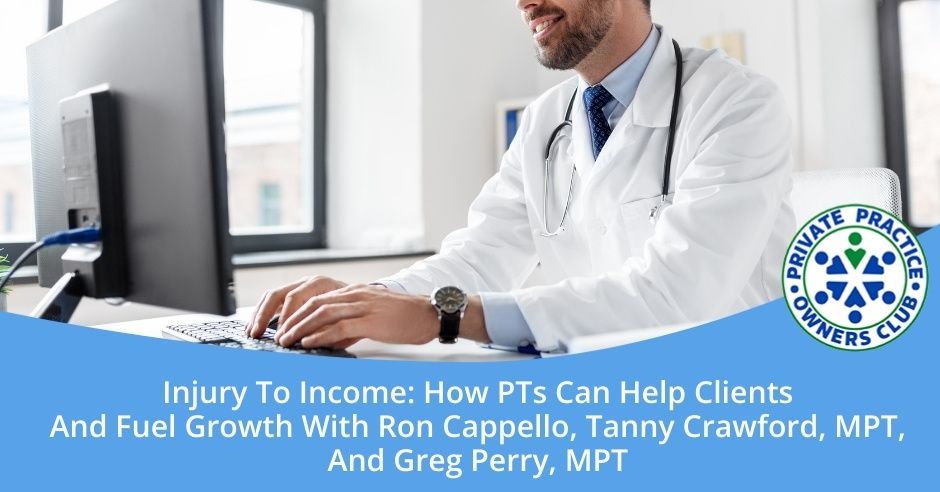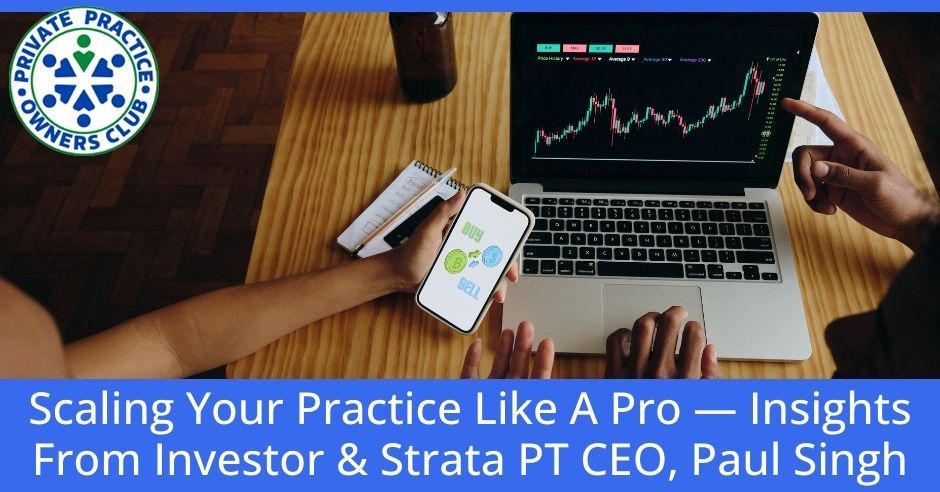Which Of The 5 Ownership Phases Are You In? How To Stop Running Your Clinic And Start Owning It With Blaine Stimac Of Health & Rehab Solutions

Blaine Stimac started with one small clinic in Kalispell, Montana. Today, he’s the founder and CEO of Health & Rehab Solutions, leading 40 clinics across five states. Few people in our industry have navigated the growth journey at that scale—and even fewer can break it down as clearly as Blaine.
In this episode of the Private Practice Owners Club Podcast, Nathan Shields sits down with Blaine to unpack the five phases of private practice growth—from the scrappy early days of solvency to scaling multiple clinics with strong leadership teams.
They dive into:
● The hidden challenges in each phase of ownership (and why most stall out in Phase 2)
● How to know when it’s time to hire, expand, or shift your focus
● Why profits aren’t linear—and what to expect as you grow
● The leadership leap every owner must make to scale beyond themselves
● How to keep your systems running even when you step away
If you’ve ever wondered, “What’s next for my practice?”—this episode will give you the roadmap.
🎙️ Blaine will also be a keynote speaker at the Private Practice Owners Club Conference, October 2–4, 2025, in Destin, FL, where he’ll go deeper into the financials of scaling.
Don’t just survive the growth journey—master it.
👉 Register now atppoclubevents.com/homepage
---
Listen to the Podcast here
Which Of The 5 Ownership Phases Are You In? How To Stop Running Your Clinic And Start Owning It With Blaine Stimac Of Health & Rehab Solutions
A 7-Year Journey Of Private Practice Ownership
I've got a guest who's been on the show. I think he was in 1 of the first 10 episodes that I did back in the day, seven years ago. He's been on in between that time, but I've got Blaine Stimac, founder and CEO of Health & Rehab Solutions, with 40 clinics across the nation. Congratulations and thanks for coming back.
Thank you, Nathan. Thanks for having me. I want to say we might've been 3rd, 4th, 5th, maybe definitely inside the top ten, but one of your first handful shows. I'd say it is super neat to be able to circle back and do this again and watch the success that you've had on that site, too, because I think it's great.
Thank you, man. If I recall correctly, I think you were probably close to 18 to 20 clinics seven years ago. The growth has been so cool to see that you're up to 40 and across five states across the country. That's really cool. That's awesome.
Thank you.
I especially want to highlight Blaine because he's going to be at the Private Practice Owners Club conference that we have October 2 through 4, 2025, in Destin, Florida. I’m excited to hear what he has to say. We're not going to talk about his presentation, which is going to be regarding financials and scaling in Destin, but we're going to talk about something else. I just want to highlight that he's going to be there.
If you want to hear that material and you like what he says, make sure you register for the conference at PPOClubEvents.com. You can register there and bring teammates. You get an extra $100 off if you use the code TEAM100. If you bring a clinic director or office manager. We want them to be there as well, so they can be aligned with you. Blaine is going to be one of our keynote speakers. I especially invited him because he's got 40 clinics.
We want to hear from this guy. How do you do that, because you were at one time just one small clinic in Kalispell, Montana? We want to hear how you did this. Our material is going to be about what Blaine has learned in these growth phases because he's been through all of them, and he's broken it down into five phases of growth along the ownership journey that we want to talk about.
That way, people who are tuning in can maybe see where they're at and maybe get a greater perspective of what they are working on, what they should be working on. What the next phase looks like for them and how their focus will change. I think a lot of times we just think we just keep doing the same things without thinking that “Maybe at this point I need to change my focus a little bit. My priorities change as I grow.” Blaine's been intelligent enough to break that down into five phases. You can share that with us.
You bet. That sounds great.
Cool, man. As you're looking at this, how did you come up with these in the first place? What was your perspective that finally helped you recognize there are these five phases?
I went through a little bit. In our expansion, we've got a strategic partnership model. One of the things that I went through is I went through my own challenges as a practice owner, my own growth cycle. As I got through that, and as I developed some of the successes in my practice, what I found myself enjoying was spending time with other practice owners and solving the problems of a practice, helping practice owners succeed and achieve what they wanted to and overcome the barriers that I think that we commonly face and that I faced in the early phases of my journey as a private practice owner.
The more clarity we have, the more focused and intentional we can be with our actions.
In doing that, obviously, my evolution and journey through private practice into what became HRS, which is our partnership model, where I actually also, in teaming up with other private practice owners, I wanted to create an understanding and what we would be going through and how our focuses would change. Also, to make it real at each one of those phases, what needs to be done and make it like the more clarity we have, the more focused and intentional we can be with our actions.
You sit down with your partners in these clinics, and you take them, or you at least teach them, train them on these five stages. They're very clear as to what they're dealing with and what's next.
You're exactly right. We set it out. We make it clear. When we're in a certain phase, the expectations are proper and appropriate. Our areas of focus, what we're prepared for and what we're expecting is more clear, which allows us to then keep the ups and downs of those phases a little bit more in perspective so we can deal with them better because I think those ups and downs sometimes, if we don't see them correctly, we misread them a little bit. They can knock us off course. They present more problems than they need to. Sometimes going through a hard time is actually part of the process, and we need to embrace that. That's not always clear.
It's easier to deal with a problem when you know that's your problem. You're aware that that's what I'm dealing with right now, “I should expect this.” It's usually when it's unexpected and we're unaware that that's where we are, and we're not clear as to where we actually exist in the phases that we might get thrown off a little bit.
Exactly right. When we're in that, and by laying out the understanding of that and the phases that we're going to go through, then when we dig into the phase that we're in and we get deep into the programming and we're strategically planning through that phase, it allows us to really understand where we're at. You said it well. We do that. If we understand it, and like you said, it's a little bit more expected, our perspective certainly changes.
Phase 1: The Basics Of Solvency - Getting Out Of The Red
Where do you start with phase one? Phase one is like, this is day one opening. I'm sure there's a time where there's strategic planning and maybe even marketing before day one, but it's that stage. It's like immediately before and after opening the doors, right?
Exactly right. Phase one. It doesn't matter whether we're talking about an acquisition or whether we're talking about a de novo. Even that lead-in phase that you're talking about, as far as preparing for the company or even the process of the acquisition itself, we start day one. Let's say that all the lead-up to day one in our first day of seeing patients is still part of that first phase.
I'm going to say the first phase, we call the basics of solvency. What that means is the first phase of any business, which is actually agnostic of physical therapy, is whether we can get to a cashflow position? Can we get out of the red into the black? Can we get through startup? Can we get through that initial phase? Oftentimes, like you said, it costs money to get started. We had all these things. We had our debt, or we had our capital funds, or we had our loan, or we had whatever we're using to get to the point where we're seeing our first patient.
For a period of time after we see our first patient, we have operating expenses greater than the income coming into the practice. The first thing I have to do is close that Delta. The first thing I have to do is ensure that I no longer need debt or capital to continue to exist. In other words, am I making enough money now to cover my bills, and hence the term solvency, which is right. I can have enough income to cover my outflow or my bills.
The common problems that you have in there are anything more than just making sure we can cover those bills, or are there some other common issues that you’re dealing with the phase one?
At the end of the day, a business is a financial activity, particularly even if we're a nonprofit, but as a for-profit company, the first thing we have to establish, assuming we don't have some level of subsidies. We have to establish some degree of solvency. Large-scale, again, industry-agnostic data on businesses will tell us that two out of three businesses never make it past a startup. They never make it. Usually what there are various reports out there, but within 3 to 5 years, depending on their capital pull.
They're going to go out of business, and they never really make it out of stock. They never ever got to the point where their income exceeded their bills, now for whatever period of time that they were able to exist. Phase one is that now, when we talk about this for a physical therapy company, what we say is, and I mentioned the term basics and solvency. The question is, can we get enough of the critical fundamental basic actions of a practice done well enough to get solved? You guys say, what are those basic actions? Here we are.

That's what I was going to ask.
First basic action. When the day we open our clinic, other than our mom and our grandma, who are going to come to see us anyway, can I get a new patient? Can I get patients to come see me? Once I can get them to come see me, can I get an inflow? Can I market? Can I establish a flow of patients other than my family members who are going to come see me anyway? At the startup of my business and they were there at my ribbon cutting. Other than that, can I get patients coming in the door?
Once I get them in the door, can I manage the front desk and the proper actions, getting them properly managed as a patient and then seen in the clinic? Once I'm seeing the patient, can I collect the money? The basics of that are, can I get the patient properly managed and see the patient, do a good job in the clinic, and collect the money? I need those basics really being leveraged into, because a lot of times on day one of a clinic, the practice owner is the therapist.
They are the marketer. They are at the front desk. As I start to go, how do I manage? I don't have a lot of time for a lot of other things. If I do that well, new patients are going to keep coming in, and the load at the front desk is going to get heavier. The first person I'm going to hire is a front desk person to unload my lines, which allows me to continue to market and then be the treater and see the patients.
If that keeps going well, my caseload is going to continue to grow, and pretty soon, I'll have less time marketing and hopefully the relationships and the flows that I've created are consistent and stable enough that I can grow myself. I've got a full caseload and I'm tapped up. Now I would have to get into that position of hiring. A lot of times, we'll get to that spot. The interesting thing about phase one is I can go into the black, and then my very next hire puts me right back in the right. I have grown a little bit more. I get back into black, and then I go right back in the right. I go like, I played this teeter-totter game.
That's scary for that.
It's tough.
They're expecting this upward into the right trajectory of cashflow and profits, but it's not like that at all.
Not like that at all. It can look good. That's why sometimes I even get a little bit scared to hire because it could mean, what happens when I do here? We have to realize, “What are those first few hires that it's okay to cross over and then play that game?” It's expected. If I'm on the right trajectory, like you're talking about, and I continue to do the right actions, the basics, and I keep leveraging them, I'm finding my success, I'm leveraging into them. Even when I pop back to the red, that's okay. I'm going to keep doing the basic actions.
I'll keep a general growth goal. You got it. More patients, more volume. Pretty soon, when I get there, it's when my next hire takes on the next expense, it doesn't put me back in the red, and you're like, “I am now officially in the black and I'm now no longer needing a line of credit to pay my bills. I'm no longer leaning alone or pulling on some other capital source in order to pay my bills.” We would say, “I've officially achieved solvency and I'm through phase one.”
You would say you talked about some of your first hires, of course, that front desk being the first one. After that, is it some other support staff, or are you thinking in your mind, and your experience, it's been either a physical therapist assistant? We have other people besides physical therapists on here, but it's an assistant or a provider at that point. You start adding those in, taking yourself out of treating and repeating the cycle to get more patients, more volume through marketing, see more patients, and get paid more.
Correct. I got to have a good beat on all that. I've got to have a good understanding of how that's working. The financials, what I need to make that go right. Usually, the third hire would be a therapist. I got myself as the first hire. I'm the owner, the therapist. I'm the first employee. Doing everything. I've got my front desk, which allows me to leverage into those other two key basics, which are marketing and treatment.
From there, I'm going to bring on a therapist because let's say I'm doing 60 visits a week and I'm pretty stacked and I'm trying to still run the business, which I'm doing. I'm pretty thin as a practice owner at that point in time, I bring on a therapist, and now all of a sudden I've got another therapist, and my immediate knee goes back to the marketing. I'm going to lever back up my marketing and try to keep that ramp going, transfer some patients. If I do that and that person ramps well, then we could get to that bubble where we're both full.
Two out of three businesses never make it out of start-up.
I had one of two choices at that point. Do I hire support staff, which allows the two of us to maybe push our volume a little bit and depending on my case load mix? If I have a lot of Medicare, that's a problem. As we know, support staff, we cannot use them, nor can we bill for that time with Medicare. It also can depend on reimbursement and a variety of factors, of why I may make the choice or do I actually go to a third treating clinician provider, and then I'll bring in a tech later.
Once I cross into a certain zone, I have to decide if I'm still the main marketer, but a marketer and someone to continue to drive business is going to fit in there. Again, we've got 16 companies that make up 40 locations, and about two-thirds of those were startups, and the remaining third of those were acquisitions. In our startups, some of our successes in those early marketing days, there are times when our successes in marketing are outpacing our ability to bring on therapists.
We aren't trying to bring on another marketer. We've already got the patients. What we're trying to do is catch up on the clinical side. A few other areas. There are other times, and it also has to do with the strength of the owner. Do I like, “Am I strong at marketing? Do I want to spend my time in a treatment room because that might dictate who I hire next as well?”
At least you're at that point where again, you're solvent. We're paying the bills. We're getting a minor profit margin. We can afford to bring on that person. That puts you into phase two. Now going into phase two, these are some of the decisions that you're making in phase two is whether to bring on the other market or a third provider, right?
You got it. To tap on phase one for a second before we cross into phase two, the mentality that you have to have, like you're lean and mean. There's no extra spending anywhere. You scraped for every visit. You don't want to lose a visit anywhere because that's your income source. You're lean. You're not expending in places that, as you grow and as your budget shifts, you might start to take on. I think I do see mistakes made because we evaluate a lot of companies as well, where they were acting like a phase two, phase three company, day one, and they could take on too much debt because you cannot support the equipment, the level of equipment.
They'll have a beautiful clinic on day one, ready for six therapists on day one. That's a lot of expense. I just took on a lot of debt. I've got loan payments, or I've got too big a facility. I should know the right size. That allows me to grow. How do I get into the right lease rates? I don't need to be on the corner next to Starbucks. What do I need to do so that I have the right mentality of being lean in mean during that startup phase, and I'm grinding as an owner, which we grind a lot, but I definitely have to understand that phase and embrace that phase.
I'm glad that you added that on because a lot of people do that. Maybe they spend $250,000 or $300,000 on billed out. Now, it’s going to be hard to get yourself out of solvency.
Phase 2: Fundamentals And Viability - Building A Solid Foundation
You're exactly right. You just gave yourself a huge mountain to overcome. I've seen practices that never overcome it. Hence, they never got out of phase one. They never got there, and that load becomes the problem. When I go into phase two, I titled this phase fundamentals and viability. We're going to take the same basics that we had to lean into in phase one. Now we're going to actually progress and continue to get fundamentally strong. How fundamental our marketing actions should get very fundamental. I'm leaning into those fundamentals, and I'm just strengthening them.
We know what works, and we're just doing it at a higher speed and volume.
Fundamentals. The marketing gets my pattern, my cadence, my frequency. The front desk should be getting very standard. Those fundamentals are getting very standard, very consistently performed. What am I replicating the standards in the treatment room and in the clinical side with my clinicians? If I'm doing that well and I continue to strengthen those fundamentals, I'm now going to go from just being in the block to now starting to have a little bit of viability. I always say viability. How alive can I be? In other words, how many meals can I miss and I'm still be okay? If I can only miss 1 or 2 meals and I'm in trouble, I'm going to go right back in. If we think about it that way, we think about it in our lives. Do I have enough reserves? Do I have enough distance there where I've got some space between my breakeven spot?
You've got a relatively healthy margin. You've got cash reserves. You have access to a line of credit at any given time. You're relatively comfortable financially. You can focus a little bit more on running the systems and fine-tuning those. Again, they're replicable, whether it's a marketing system or a patient care system, or the front desk system. These things are getting fine-tuned and efficient at a consistent level, so you can create consistent profitability on a regular basis.
You got it. Getting really fundamentally sound. You described a financial scene with a line of credit. Most often, for us, we're not at that spot where we have that. We just have the beginnings of these margins, and we have consistencies in these margins. We haven't been able to necessarily pay down all of our debt yet. We try to go through this phase really fast. This is our phase two. We can go through this phase pretty fast.

I'll say within six months, which doesn't always give us the time to achieve those other financial targets. If I hang out in phase two for a couple of years and it's not a horrible place to be, I don't think we've optimized or achieved our full potential yet, but then I would start to achieve some of those other financial targets that you mentioned. It really depends on how fast we go through that phase and what our intention is in our growth strategy.
I love that you brought up the time factor because phase one could be any amount of time for any owner, dependent on how much debt they take on, and if they overbuild versus the underbuild. If their marketing systems work or don't, there can be so many factors that determine the timeframe in phase one, I'm assuming. I don't want to put words in your mouth, but would you agree?
I would agree.
You're trying to run through phase two. That makes me wonder, do you think a lot of owners who have a relative measure of success tend to stall out in phase two?
I would say most private practice owners and I've been a PT for 25 years in private practice the whole time. I've gone through a lot of phases of spending time with private practice owners. I would say the average small private practice owner gets mid-phase two and stops. They ride their whole career mid-phase two.
It’s because they're doing okay. They've got some money. They've got a little cushion, but they're not pushing. You said it right. They're not maximizing their potential.
They don't know quite how to run the business. They don't always know where their holes and leaks are or how to close them. They're usually not doing anything too crazy. They're not way off in left field doing really silly stuff, but it's too many things not done well that add up to a lot of thin margins. The irony of it is, once you get there, Nathan, as you know, the reasons I don't correct things are like they almost become a self-perpetuating cycle. I don't have the mind to do this, which is why I don't do this, but that keeps me in a certain phase of operation and in a certain mindset.
If I don't know how to bust through that, which is the hard part, and it's challenging, because I'm finally like viable, I've got a little bit of breathing room financially, and it's risky, like, “What do I do here? How do I go through? How do I manage that well?” It's a tougher thing to manage because by this time, I have a fair number of staff. If I don't know how to replicate those fundamentals, and I don't know how to actually get those done well across the board, then what happens is, and this is what happens. I know you've seen this through your career as well, where that practice owner starts to have to do more to make up for what their team doesn't do. There you get sticky. When that happens, you get sticky.
I love the fact that you push through this purposefully because you recognize it, but I can see looking back, this is where I stalled out, and I was ten years into practice. I didn't know what I didn't know, but I was doing fine financially. I didn't know what needed to be changed to get to the next level until I got some coaching and consulting to teach me. Being a good therapist got me that far. That's as far as you are going to get unless you get some education.
That's where coaching and consulting come in. Like, “You got this far on some grit, hard work, and maximizing the most of what you can do, and maybe reading some books and listening to some podcasts. Now you need to take it to the next level.” It does take a little bit more risk than maybe we're not used to, but the financial stability is there. It's there, kind of not, but it's relatively comfortable. You're still out. I see that.
When you gain that, now you're finally making a little bit of money. Not enough to hit all these financial goals. Sometimes they're not super aggressive at our debt reduction, but I also am not in the red anymore. I also have a little bit of money now. As you said, whether we get comfortable, whether we get a little bit scared to disrupt that, either way, we don't know how to lean into those next levels enough to blow through it.
We're like you said, we're stuck in the systems. We're not leveraging our team. We are a majority of these systems. I cannot imagine pulling ourselves out of those systems, and they still run properly. When you approach that point, you're pushing through, and what tells you then that you're getting into phase three and out of phase two?
You bet. Again, we have different things we focus on in that phase. We're talking about it from a high level. What are we doing at each one of those areas, as far as, like you said, the systems? We've got so much stuff systematized. If you haven't yet, as a practice owner, that's where you want to start developing your systems. That's where you want to start, like saying, “This is how I'm going to get my systems documented. My process is documented, properly trained.” When I break in and we would define viability as about 50% of the available profits of a well-run company. Let's say a company can be 20% profitable. We would say we got viability around 10%. As an example.
When we expand, we're taking on a whole new set of challenges.
That’s a good metric to go off, generally, you would say nationwide?
Yeah, it's pretty good. In some areas, we might be closer to optimizing closer to a 15% or 16 % margin, depending on reimbursement, cost of living, and cost of doing business in that area, but still in that 8% to 10% zone, I've got a little bit of breathing room. I can think a little differently, but I still have to be very disciplined in my thought process, physically, and in my decision-making. I have to know again how to really get consistency and continue to leverage for growth. As you said, if we don't bust through that, it gets to be a very sticky spot that we can hang out in for a long time.
You hit that. I'm sure there are other metrics, but you hit a relatively, what might be expected as 50% of your maximum profit capability in that clinic, which could be 10%. You've got to stop that and establish viability. Now you can move into phase three.
Phase 3: Mastery And Profits - Optimizing Your Clinic's Performance
I move into phase three, which I've titled Mastery and Profits. Now I'm going to become a master in running that clinic. I got my basics in. I developed my fundamentals, and now I want to master them. I'm getting good at it now. Just like a PT, at the beginning, I get my basics in school. I figured out how to run my fundamentals. Now, after I read that and after I have some time, I start to become pretty masterful. I should be good at it. It should start to become easy for me to understand how to run a front desk. Easy for me to execute on those different aspects of clinical.
What should my therapist be doing? I've got some systems in place. I understand my metrics, and if I lean into that further and continue the growth cycle, then I'm going to become profitable. Now I'm going to go from that 50% up to what we would say I'm now achieving profitability when I'm at 80% or so. If it's a 20% capability, we're going to say at 16%. I'm starting to optimize my financial performance of this company based on the operations and how well I'm operating. If I'm a master and operating it, I really understand how to operate a clinic.
When you say master, it doesn't necessarily mean that you personally are mastering the systems, but you've mastered the ability to make sure the systems are running by understanding what the expectations are and holding people accountable for running the system.
You're exactly right. I know exactly how it should go, and I can run it well. I can hold people accountable. I can get it done by others because this time, let's see what I probably have ten dozen staff by this time.
Of that, maybe 4 or 5 providers.
Got it. I would say it is typically a sweet spot. Now I can stay there. I can have a 5 or 6-therapist clinic. If I'm running it right, I start to achieve that. I've got a multitude. I got a pretty large income to cover my infrastructure, my rents, the costs that come with running a clinic, not just my staff. As we know, Nathan, every time I had a clinician and I could get them productive, my rent didn't change. My fixed expenses have not yet changed. Now they become a lesser and lesser percentage of my overall expenses.
That's how my margin per therapist doesn't change, but the whole way we run the clinic, if I'm there, the risk to this is I expand and I make those hires, and my overall productivity drops. Now we've expanded ourselves into a tough situation. Again, usually the owner can oftentimes try to solve this by working their butt off, by overworking there and not fixing, like you said, the team, the systems, the structure, enough to be able to work on the things around the business because they're too in it.
I got it. Yeah. You can easily fall out of that system, like you said, any one of them can be vulnerable to external factors, but you can easily fall back from phase three to phase two simply by a provider or two leading unexpectedly. Understanding that, maybe that would make some of these losses that you get on the productivity side more bearable is just knowing that I was comfortably in phase three had some unexpected losses. I'm going to have to go back into phase two and run through that again, get back up to phase three, and higher profitability margins.
When that happens, I usually say “Welcome to the game” because that's part of running a clinic. It just happens. You're like, “I lost someone.” You're right, it can wiggle you through those phases. If I really know what I'm doing, I'll recover quickly. I'll go back in. If I have my systems, I'll bring the next person on. You got it. It's okay. It's like, if I haven't caught that, because the first time we don't have that, but again, know what you're up against. It's okay. How do I learn from that? How do I grow from that? What are the lessons that exist in there? Sometimes it's just part of the cycle, and sometimes I'm like, “Am I growing and learning through each one of those steps?” If we are, then again, we'll strengthen as we go through that and deal with the ups and downs of that phase.

I appreciate that you say that it's part of the game because people might just expect, “I'm in phase two. Now I'm in phase three, and I'm just going to stay here.” No, that's not always how it goes. There are plenty of times where maybe it's not losing a provider, maybe it's losing a key referral source, or changes happen to an insurance contract that you weren't expecting. That can definitely make some changes. Now you have to reconfigure the system, which is a phase two operation, and learn how to master it over again.
Got it right. You can adjust to it. Let's say it was the referral source. I can now go. What would I do to not be as vulnerable to that? Now I have just become stronger as a business. I developed phase three a little bit when I put it together and learned from the experience that we went through with some of our partners and the experience we went through with some of our companies while we were growing. We went through phase two pretty fast, as I mentioned, partly because we had a lot of things already systematized. We already had this developed.
That's a lot of what's valuable. What we do is we have so much dialed in already, it can happen very fast. You can just plug it. You got it. Financially, we're moving well as a company. We move into phase four, which I'm going to lead to growth. If we haven't mastered it, so we move from phase two, our numbers start to look like phase three, but we don't have it all the way dialed yet, and then I go expand, then I run myself into a problem. It's almost like I need to really make sure I would got I'm solid here before I take on. When we expand, we're taking on a whole new set of challenges.
When you expand, you're talking about either taking on significantly more space or a separate location together. That’s what you mean by expand, right?
You're exactly right. Location two, or let's say you double your square footage, which allows you to double your therapist, but even more so, Nathan, when we talk about opening a second location, is now I cannot touch everything every day as the owner. I now have to start to split time. What my staff are doing, the systems and structure start to matter more and more. If I just felt my footprint in my existing location, it's easier because I get to see everything. I'm there all day, I'm there. I'm not splitting my time between locations, but a great litmus test for this is if I leave the clinic for a period of time, how much does it change in its performance?
Does it operationally do the same things that it was doing when I'm there and when I'm not there? If I go to expand in a new location and I have to leave, and that clinic wiggles, well, guess what? That was funding all your expansion. Bad news. Again, we can then expand ourselves into a problem. We thought we were doing the right things. We got cocky because we're like, “Look, this is going well.” I'm like, “I wasn't all the way ready yet. I made that move a little too soon.”
I can definitely see a few things, like maybe you haven't, there's no strain on the systems if you're always present. Taking you out as the answer man to all the questions, or I like to call it, if all the systems are centralized around you and you have to be physically present in order for those systems to run, even if you're not running the systems yourself, then it's all on you still. The strain comes, like you said, and it was a challenge that's put forth in a book called Clockwork by Mike MiChalowicz.
He's the same author as Profit First, but we read that. The goal was to get out of your company for four weeks. What would have to happen? This is the litmus test that they provided. What would have to happen? What would have to be true for you to be gone for four weeks? It's still, like you said, continue to run and maybe even do better without your presence. That's what you're striving for in phase four, right?
Totally. That's a great target right there, and it makes you look at things through a different lens. If you put that target out there, what would have to happen for this to become a reality? Excellent way of looking at what would need to get done, and do I have that done? That's what I'm working on through that phase is being able to do that. I usually want my write-ups completed. I want my training and onboarding programs pretty dialed in. I want someone else who can run. I've mentored other people in roles other than just being a physical therapist. I have a director who can run the clinic when I'm gone. These are the things that you're talking about that would have to happen there.
Are those things that you start building on in phase three, or do you consider yourself in phase four prior to that expansion, building on those things with the expansion in front of you?
It's very fluid, as you mentioned earlier, you can wiggle back and forth. It's like when you cross over, you can be in between, and you can still have like things you're working on as you cross over, and you go and you keep working on it. It isn't like, “Now I'm here. This starts.” We're continuing that process, but what it does is it puts you in the right mindset. A great example was just what you shared, which is if I took this viewpoint, how much different would I approach what's there, and how would I be intentional in what my quarterly plan is?
What am I trying to get done this quarter? When I say this was a successful quarter, maybe it was. I could leave for a week and do what you want to. I want two weeks, and then I want three, and then I want four to work toward that target. Each quarter, I could decide what I am going to work on as far as system development, ensuring well-being is processed very appropriately.
At the end of the day, if you've made it into phase two and particularly if you've made it past phase two, then you are good at what you're doing. You are skilled. If we know that the next thing I would have to say is that we have what's called proof of concept. I would need to begin to document. I would need to begin to make sure I can get those successful actions replicated. I need to document and master that. To document is the first step. I have to have my metrics and my performance measurement in line with what is high performance and low performance.
Expanding initially costs money; we must be intelligent, strategic, and intentional in its use.
If I've got metrics, I understand how to measure high and low performance. I'm documenting the successful actions. Now I can begin to duplicate those actions. Once I duplicate, now I've got to hold myself accountable. Right now I'm starting to work. My growth at that point in time as an owner is more around understanding how to scale the business, understanding how to run the business, and set my people up for success, and run the accountability and continue to strengthen the systems, the structure.
Phase 4: Team Development & Structure - The Blueprint For Expansion
That's part of phase three, looking forward to phase four is developing a core team, it sounds like. That business system is for you.
It’s all about the team development structure entirely. If I do that well, you can see phase three feeds right into it. I'm starting those process documents, but I may not have them all the way down. I'm pretty good. It's still revised by me. I haven't built out my whole team yet, but I'm going to open it. If I get in, if I can focus on team and structure and expansion, now I can talk about opening another clinic. If I have everything well documented, I've got good metrics. I know how to look at them. I've been training my team. I can duplicate.
If my front desk leaves, like we talked about, I get a little bit of a curveball. I show up, and I get a resignation. Good. If I've got everything processed and documented, I know my data, I've got onboarding built, I would just go ahead and replicate, duplicate. Repeat. “Good. Keep going.” If I don't have any of that move, which we named welcome to the game statement right here, of course we're going to have that moment where as sometimes as a rookie or as a young practice owner, young in my time in the game as a practice owner, not necessarily my age, we don't see that coming all the time. We are ready for that.
We're all in this together forever.
It's Kumbaya. This is great. The first time I get, and then I feel like I got, “What just happened?” I'm not ready for it. Again, knowing what you're going to expect and being ready for it, like we spoke on earlier, and having mentors and leaders and people that we learned from allows us to work through those moments better. Those moments can slow us and knock us off our horse for a lot longer than they should.
Prior to going into phase four, would you say that you probably have a clinic director in place and operating at a consistent function for that singular location before you go into phase four? Is that not altogether necessary?
I would say as long as you have one identified and you're in the middle of training, because that mentorship and training cycle is not fast. It's much different than putting a front desk computer. As long as I have it, if I try to do it without, I'm going to start to get spread thin, and then I'm not going to have enough time. I don't have to have them perfectly trained. You got it.
Now you're spreading yourself thin with construction calls and making decisions and all the other marketing that you have to do to open the second location. Now that the clinic director isn't there on-site. If there isn't at least, I can see what you're talking about. If there isn't some junior or assistant to the clinic director, then no one's on-site to hold accountable, make sure the metrics are being met, and reported. I can see that at least having some singled out as responsible, I see.
Being prepared to manage through that and having that director there and being capable of continuing to provide the leadership development that's needed, provide the mentorship that's needed, teach them what to do, and get more and more space and distance. If I do that, if I've got that in place, then as I start to open the clinic, I can usually juggle it pretty good. It's going to be another high.
Just like in the early days when I was the one seeing all the patients and trying to juggle everything, this is another high-juggle time. I am thin again, but if I do the right things, it's going to bring me through that, and it's going to be worth it. There are times that we get super thin, and then there are times we gain weight. We earn it back and through that growth cycle and that inflection point that we run into.
You're going to go deeper into the financials of scaling at the conference, but you can see, as we're talking through this, phase one requires a lot of cash, phase two is very almost breakeven, maybe a little bit more. Whereas phase three, now we're talking about nice cashflow profitability. Phase four is just going to be another cash drain. I think some people are, maybe they understand it, but they don't recognize that it's not going to be super profitable until that second location also gets to phase three.

You got it. Absolutely, initially, it costs money to expand. We just have to be intelligent and strategic, and intentional in how we use it. My first clinic has to be in why we talk about achieving a profitable clinic before we expand is because it has to fund that expansion. We've opened a lot of clinics, as I mentioned, the number of de nobles we've done, and never once did we use debt to open the next clinic.
We always had our clinics running well enough that it was able to fund the expansion that we needed, and that became an important part. Otherwise, I continue to play. I wouldn't say there's never a time to utilize debt again in an expansion, but we have to be smart with our debt leverage as a company, too. That's one of the things that hurts when we talk about companies that made it out of startup, but fail.
Eighty percent of all companies will fail within a certain period of time and usually 5 to 6 years, and only 3% to 5% of all companies exist 10 years later. Some of them exited, and some of them were there, but we have this phase of people who made it out of startup, but never really became successful as a company. That can be an example of a practice owner who ran this thing for 7or 8 years at really thin margins, is like, “What am I doing? This is a drain. I don't want this,” or ‘I'd be better off to do this or I'm going to pass it on. I'm going to be done with this.”
Oftentimes, that comes with an expansion move that never panned out. That's an example of like, “Was I really ready? When I did it, I could go through that.” When we talk about phase four being an expansion-oriented phase where I'm developing my team, I'm understanding my structure. Now I have a clinic director, and we talk about using it to go to 4 to 5 clinics.
You're staying in phase four until you really expand into not just 2, but 3, 4, or 5 clinics.
Phase 5: Aggressive Growth - Leaning Into Strategic Acquisitions
We can be in there for years. You got it. Some people will never get out of that, even with a very successful clinic. We would call five almost like an aggressive growth phase.
You are a court man.
We are leaning into it. Our acumen is very high that we're going to use debt more aggressively at this phase. We're willing to look at acquisitions, faster growth. This is the value of having a team that understands how to do this. We can work through this. We get into these phases. If I can get into the 2nd, 3rd, and 4th clinics, now I need multiple directors. I need a VP. I need a desk leader. That's the structure and team development that continues to happen through phase four. As you said, it's all about team development. It's all about your team, your people, and your systems and structure.
It's hard to put a timeframe on that one because it's just each clinic has its own beast, and how quickly it gets to phase three can be very variable. It's a higher game. When I also look at it, I'm going to talk to it a little bit at the conferences. Getting to phase 2 and 3 takes a level of management acumen where you're running systems and making sure they're run and that stuff. Going beyond phase four, you've got to learn a different skillset. Now it becomes more of a leadership skillset. You're not at the management level of things anymore. You're like leading a leadership team. You are the leader of the leadership team. That's what you find yourself doing in phase four, don't you?
Absolutely. By this time, I shouldn't be heavily connected to the treatment lines.
Where is your clinic, right?
You're exactly right. Now, how do I continue to grow? What is my educational growth pathway? I love that you brought that up. Where a lot of practice owners, when we're stuck in a PT mindset and we fail to understand the leader behind the business, we think we're going to solve our problems by becoming better clinicians. My educational pathway might be around, let me go get my OCS. Let me go get manual therapy certified.
Let me go to get my fellow, who isn't going to run your business any better. Now, what you just brought up, excellence, which is okay, how do I grow as a business owner, as a leader? What do I want to study? What books am I reading? When am I willing to pay for some cementership and some time? What is my education growth path? I should be very intentional on that, too. Like, what do I want to accomplish in the next year with my own personal and professional growth?
Our willingness to fail and ability to embrace those failures allows us to move faster, extracting value from each setback. It's a teaching lesson, an outgrowth moment.
I can see that. It's just another level of development that I don't think a lot of people are expecting. They think they can get to phase three, maybe they do a phase four, and that can be very rough waters for some people, especially if they're still treating a little bit. There's some profitability there. They've got other providers, and they're treating a little bit, but they never take on the leadership mantle and learn how to develop other leaders, and that can get them stuck.
You're exactly right. That will be your tough point. You will hit a ceiling at some point in time without doing that.
Very cool. Anything else you want to add regarding the five phases? This was cool stuff. I love talking about it.
Of course, any one of those phases, we can talk about what would need to be done and where I want to focus on and how I progress through the phase, and focus on the next thing, like leadership, and what do I do? Where do I go? There's so much good information out there, from your podcast to books to read. Just to lean into that leadership discussion, I have found a ton of value in John Maxwell's books. I think he's probably the preeminent, like in leadership, in my mind, he's the gold standard.
Again, for the listeners, he has many books, but even starting with The 21 Irrefutable Laws of Leadership to Developing the Leader Within You, and the different stuff. He has a great book that's called Failing Forward, too, which is about being okay with failing and being able to do it. I listened to him talk at a conference as well. He was talking about coming out with what I think was supposed to be his hundredth book, but the book was going to be How to Get the Most ROI Out of Failure. I love that title. That's something I wish I had learned earlier.
The willingness to fail, the ability to embrace our failures. I think we would move faster, but to get ROI out of failure means I have to be willing, like, “I failed. Now what's the value?” That's a teaching lesson. That's an odd growth moment. If I understand how to work through it, I understand how to manage it. That's why understanding the phases you're going to go through in business is so valuable, because then I can embrace that moment and I can try to get the most value out of that moment.
It's okay to go through it. It will strengthen me if I do. Hence, the concept of ROI comes out of those moments. I just thought it was a super cool way of saying it as well. Another thing that I would say again, if we can grow there, that's an area, if you say, “What would you do earlier and sooner and faster?” I would absolutely would have liked to have studied that material. I would have liked to have had a better perspective on that earlier in my career.
Beyond Clinical Skills - The Evolving Role Of A Leader
To learn what it's like to be a real leader because we are the de facto leaders. Once we open the clinic, we just don't know it. It also takes us going through those phases to actually live in truth. We are leading to an extent. We will always be the leader, and you cannot get rid of that mantle, but no one's ever taught us how to do it. It takes some training, it takes some work, and some learning. I really appreciate that you shared your insights regarding John Maxwell's stuff. That's super helpful.
You bet.
Thanks for your time. I'm excited to see you here in a few weeks in Destin on the beach. I’m excited to see you again and am really looking forward to what more you have to share regarding the financials of each of these. We just touched on some of those things. There's much more to it that you're going to share at the conference. I look forward to what you're going to share. If people want to get in touch with you and learn about what you do at Health and Rehab Solutions, especially the partnerships that you provide, how do they get in touch with you?
The best way to get in touch, our website is HealthRehabSolutions.com. From there, you can see some of what we do. We've got some good videos from our partners, and you can see a perspective there. My email is BlaineS@healthrehabsolutions.com. Not the best domain, name a long one. We probably did something there, but now that we're there, we've got to go with it. Thank you very much.
Looking forward to your conference, Nathan, and we'll go into a little bit more depth on some of the financial modeling that we do, some of the models we use, add some depth to what we talked about and how we make decisions because the financial planning and modeling associated with that expansion is what allows us to do it well and manage the curveballs because we are certainly going to have to clear hurdles at times. That will be a lot of what we try to go into with more depth at the conference, and I’m looking forward to connecting with that group of people. I love getting together with other practice owners and leaders and spending that time. It'll be nice.
Thanks for sharing. I appreciate your time, Blaine. I know you've got plenty on your plate, but it's awesome to have you back on the show. Appreciate it.
Thanks for having me, man.
Important Links
- Blaine Stimac on LinkedIn
- BlaineS@healthrehabsolutions.com
- Health & Rehab Solutions
- PPO Club Events
- Clockwork
- Profit First
- The 21 Irrefutable Laws of Leadership
- Failing Forward





